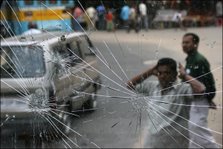Team Up! Follow The Money! India Shines!Palash BiswasIndian Caste system based Hindutva dominated society is nothing but a model of Graded Inequality which falls in line with Globalisation.
Hence I emphasise Globalisation is itself the Post modern Manusmriti. The leading forces of fascist, Nazi corporate imperialist worldwide aggression and dehumanisation of Mankind are Hindu Brahmins and the Jews controlling US as well as world economy!
Hate the other caste and culture because you happen to be superior by birth, happens to be the base of the rotten Brahminical system in this sub continent. The hate campaign international is best expressed in War On Terrorism ( Against Muslims world wide). The Economic war, which is referred as Globalisation and Market economy is targeted against Blacks and dalits, Underclasses and Refugees, Migrants and Tribals, Minorities and all the Rural People in the third world!
Without an International dalit movement we may not be able to address the Menace globalisation!
They have teamed up!
They follow Money!
India shines for them!
The urgent need for integration in the world economic system for economic growth and development has been identified!
How the Communists in India have changed the Ideology to address globalisation, the models are Nandigram and singur!
Hindu Zionist State power does not understand that Sustained peace and stability can not be guaranteed when the disparity between the rich and the poor, in a nutshell-the haves and have-nots, does not only prevail but also widens!
And this is India Shining!As a country, we have seen the most unprecedented transformation of the economy, ranging from macro-economic stabilisation to the industrial, labour, fiscal and monetary policy reforms. For whom?
How do we address the post modern Manusmriti, Globalisation?
It is essential to understand the nature of conflict in order to address them. ... The globalisation is as fast as the conflicts intensify.
They proclaim globalisation as the total solution to the world problems!
We search of increased foreign direct investment , new markets for export, and development assistance for infrastructural and human resources development has been undertaken. To achieve these objectives we have had to forge alliances with countries and regional blocs, as well establish partnerships with international organisations and trans-national corporations for the purpose of reconstructing and developing the social and economic fabric of our society and the continent in general. Hence the formation of the International Investment Council, International Marketing Council, International IT Council and others, and our close and concerted engagement with among others the IMF, World Bank and WTO.
And thus, we have been enslaved! Wasington happens to be our capital!
The motto is : Follow Money!
Southeast Asia needs to seriously address poverty and economic disorder, corruption, social injustice, basic services and food scarcity.
But the global priorities are Blue films via NET, Mobile Telephony, Auto Boom, Electronics of all kind including computers, cosmetics and consumer junk products, Infrastructure for ruling classes, shopping malls , multiplexes!
Who have to pay for lacs corore Revenue Loss due to Tax holiday for SEZ!
China has made a new production system and streamlined the old production system. this is how they address globalisation!
We evict the Rural India from its Roots, destroy the Natural sources of livelihood for the illiterate, semi literate dalit, tribal underclasses. Devastation of Agro sector has become neo aesthetics!
We have annihilated our Indigenous production system!
This is Globalisation in India and service sector has become the main source of National income, the base of Economic Growth well reflected by sensex!
China does not try English! Chinese may get jobs in Chinese language! We use the language and culture as prostitution.
This is how we address globalisation which is limited in IT sector with mushroomed call centres and pirated soft Ware!
Was Jyoti Basu a Fool who chose not to follow Global Order?
The Writers has been transformed into a Kremlin of Stalin!
Chief Minister Mr Buddhadeb Bhattacharjee today said that though there could be “obstacles” in the path of his government’s industrialisation drive, there would be no going back on it despite the Nandigram incident. “There may be obstacles and complications may arise, but we will go ahead with our industrialisation programme,” Mr Bhattacharjee informed the CPI-M state committee meeting here. Meanwhile, Intellectuals from all walks of life today took out rallies that culminated at Metro Channel near Esplanade to protest against the Nandigram carnage on 14 March.
India Sets Semi Subsidy Policy
Forbes - Mar 22 9:08 PM
Government hopes to attract $6 billion to $9 billion in investments in three years.
Members and followers of Forum of Artists, Cultural activists and Intellectuals, Democratic Students Centre (DSC) a Pro-Naxalite Students took out a procession entitled “Walk for Democracy” from Desh Bandhu Park demanding resignation of chief minister, Mr Buddhadeb Bhattacharjee and a judicial enquiry into the the incidents of Nandigram. The procession converged at Metro Channel opposite Metro Cinema Hall and held a protest meeting there. Eminent personalities associated with the Tollywood film industry like Jossy Joseph, Sashi Anand, Ranjan Palit, Supriyo Sen, Vidyarthi Chattopadhay, Mahadev Shi, Indranil Roy Choudhury among others participated in a rally.
Several artists, directors and producers of documentary folms who voiced their concern today said that they are willing to make documentary films to depict the mass killings at Nandigram. The leaders and supporters of Sagacious Teachers and Employees Association (School), West Bengal Primary Teachers Association and Prathamik Sikshak Kalyan Samity staged a silent sit-in-demonstration at R. R. Avenue to condemn the recent killings at Nandigram.
The "India shining" group may be less than 15% of our population. But they are the rulers. They have the media to shape the "public opinion". As over 80% of Indians are kept as slaves, they hardly have any opposition.
Our legislators are manipulated and made powerless.
We are once again entering into a dark era of zionist-driven Western colonialism. The Brahminical rulers are selling India to White Western rulers. We have been saying this, repeating it. But the killer Bush visit to India finally confirmed it.
Companies team up for project in India
Sunday, March 25, 2007
NEW DELHI
India's Reliance Industries and U.S.-based chemicals producer Rohm & Haas Co. have signed an agreement to explore joint construction of an acrylic acid plant in western India, the two companies said last week.The proposed plant will be located in Jamnagar along India's west coast, where Reliance -- an oil and petrochemical conglomerate -- is building the world's largest oil refinery, a Reliance statement said.
Philadelphia-based Rohm & Haas will provide technology for the plant that will have a capacity to manufacture 200,000 tons of acrylic acid and its derivatives annually, the statement said.
India expects chip policy to attract $5B in foreign investment
Electronics Supply and Manufacturing - Mar 22 9:55 AM
BANGALURU, India — The government said it expects its new chip policy to attract more than $5 billion in manufacturing investments over the next three years.
Irish firm to set up power plant in India
UPI - Mar 23 10:16 AM
India has said McNamara International, an Irish firm, will set up a 2,000 MW power plant in southern Tamil Nadu state. "McNamara International, an ...
Why this sudden Bush love for India?
OUR CORRESPONDENT
Bangalore: When Iran and North Korea are clubbed in the "axis of evil" for making bomb and punished, Iraq was invaded and pounded for "possessing weapons of mass destruction", why George Bush is waiving all norms, rewriting nuclear rules and rushed to India to sell nuclear material?
Why Bush wants India to produce bombs? And against whom? Why he tried to bend all rules for the sake of India? Why this special love?
Will not China now go out of the way to supply nuclear arms to Pakistan?
Is Bush pushing India against China? Why India is surrendering to such dangerous temptations at the cost of the country?
These questions lead us to only one answer: India has played into the hands of American Neo-Cons goaded by the country's over-fed ruling upper castes who, the history says, never had any love for their land.
Foreign investors will ditch India: According to a report the organised sector is contributing about 10% of the Indian economy. The corporate sector is even less. The much-publicised boom in the Indian stock market must not be taken as a reliable indicator of the state of the national economy and of improvement in the economic conditions of the people. The boom is due to Foreign Institutional Investors (FIIs) and the return of the laundered dirty money of Indian capitalists.
An economist warns that (1) an unholy alliance has been forged between the FIIs and Indian capitalists which may prove harmful to India's national interests. (2) Gradually foreign investors have begun exercising control over India's corporate sector. May be one can term this as imperialism through backdoor. (3) The boom hinging on FIIs may not last very long. Once they see greener pastures, they will certainly emigrate, leaving grave consequences for the Indian economy.
http://www.dalitvoice.org/Templates/april2006/reports.htm
William Pesek: Asian billionaires tell tales of their economies
Asbury Park Press - Mar 25 1:36 AM
Follow the money. It's among the first things young reporters learn about covering business. Nowhere is this bit of wisdom more useful than here in Asia. Take Forbes magazine's latest listing of billionaires. It showed a healthy increase in Asians, with the number of Indian and Chinese billionaires nearly doubling. India now has the most billionaires among the top 20, after the U.S.
http://www.app.com/apps/pbcs.dll/article?AID=/20070325/BUSINESS/70324009
A bridge too far
The man squishes through the muddy banks of the Talpati canal on the edge of Nandigram. A rail-thin figure with a thatch of ... Read..
http://www.telegraphindia.com/1070325/asp/7days/index.asp
In wake of West Bengal massacre: Indian workers must advance an independent socialist programme
Sat, 2007-03-24 01:51
By Nanda Wickremasinghe – World Socialist Webs Site
Facing popular opposition across India over the police shooting of scores of peasants in Nandigram last week, West Bengal’s Left Front government, led by the Communist Party of India (Marxist), (CPM), is desperately maneuvering to contain the crisis.
On March 17, the Left Front parties announced that the state government will not expropriate land in Nandigram to set up a Special Economic Zone. They further declared that the massive police presence in the area will be scaled down “in phases,” and that land acquisition for Special Economic Zones in West Bengal will be temporarily suspended.
http://www.asiantribune.com/index.php?q=node/5034
Alliance Semiconductor Closes Sale Of Parcel Of Land Located Outside Of Hyderabad, India For About $3.2 Mln - Quick ...
Nasdaq - Mar 23 3:34 AM
(RTTNews) - Alliance Semiconductor Corp. (ALSC.PK) said that it has completed the sale of a parcel of land located outside of Hyderabad, India for Rs. 140,753,900, or about $3.2 million.
Nandigram part of conspiracy to disturb Left rule, says BimanBose, the Left Front Chairman. Latin American multiple Grammy award singer Shakira arrived in Mumbai Saturday for her first hip-shaking Indian performance.Rice urges Egypt to reform its democracy and India says air-to-air missile tested .Jamiat Ulema-e-Hind is planning to join WB politics. Bangla nationality, betrayed by so called Hindu Muslim national leaders of Undivided India as well as Independent India and pakistan, has the golden opportunity to assert itself as the Next global Super Power India pray for Bermuda to enter in Super Eight round of Cricket carnival on which stakes happen to be billion and billion dollars. With a Bangla win, Global Market forces and Multinational Hindutva Zionist forces would have some spare time for a second Thouht!
How to Exterminate Muslims in India? by Dalit VoiceHow to Exterminate Muslims in India? Dalit Voice, Editorial, May 16-31. 1999 ... Burning of Muslim houses and shops was encouraged to destroy their economy. ...
www.themodernreligion.com/assault/india-ext.html
India Together: Caste - news reports, opinions, analyses, articles ...Ruth Manorama, voice of Dalits Ruth Manorama is a women's rights ... INTERVIEW: NARENDRA JADHAV / ECONOMY/CASTE A Dalit straddles the financial world ...
www.indiatogether.org/society/caste.htm - 26k - Cached - Similar pages
India Together: Caste - news reports, opinions, analyses, articles ...In the recent impressive gains made by the Indian economy, the OBCs have not ... Demand for the randani roti, a staple of Dalit cooking in Central India, ...
www.indiatogether.org/dalit/ - 26k - Cached - Similar pages
EJournals & Newspapers on South AsiaDalit Voice: the voice of the persecuted nationalities denied human rights. ... plus a periodical series of special statistics on the economy and society. ...
www.columbia.edu/cu/lweb/indiv/southasia/ejournals.html - 103k - Cached - Similar pages
India is supplying arms to Burma's military junta to counter China's influence in the neighboring country, but pro-democracy activists fear the junta will use the weapons to suppress opposition and resist democratization!
Opponents of the proposed Special Economic Zone stage a road blockade at Wadkhal in Raigad district of Maharashtra on Friday. Hundreds of farmers took to the streets on Friday opposing the Reliance-promoted Mahamumbai Special Economic Zone (SEZ) and blocked the Mumbai-Goa highway and other roads near Pen in Raigad district in Maharashtra for over three hours. The Government is acquiring land in 45 villages in Pen, Uran and Panvel talukas of Raigad district for the Mahamumbai SEZ promoted by Reliance.
The Shiv Sena and the Peasants and Workers Party (PWP) alliance recently won the majority of seats in the zilla parishad elections in Raigad district. Shouting "Chale Jao (go away) SEZ" slogans the protesters waved the saffron and red and white flags of their parties.
The protest was part of a nationwide action against SEZs on the occasion of Shaheed Bhagat Singh Smriti Diwas. The main demands were that the SEZ Act should be withdrawn, and a national debate should be held on agriculture, land acquisition and development.
While Chief Minister Vilasrao Deshmukh has been saying that land acquisition notices can be withdrawn he has not made any administrative move to do so.
YES, CHIEF MINISTER!
A proposal that Mr Buddhadeb Bhattacharjee must approve if he does not wish to be accused of violating Article 14 of the Constitution.
By RAVINDRA KUMAR
I am planning to write a letter to the Chief Minister of West Bengal. Here is a draft, which I offer to readers ~ who are, after all, the most important stakeholders in The Statesman ~ for comment.
Dear Mr Chief Minister,
I write this on behalf of The Statesman, a newspaper that is more than 130 years old and is directly descended from The Friend of India, founded 1818. In other words, we were born about half a century before the house of Tatas was founded as a trading firm, a reference that you may find mysterious but one that I promise to explain as I go along.
In February last year, we applied to your Housing Minister and head of the West Bengal Housing and Infrastructure Development Corporation for a two-acre plot of land in New Town, Kolkata. In October or thereabouts, some seven or eight months later, we received a letter from WBHIDCO that it had been decided to allot the land to us. But, curiously, there were no details furnished in the letter about the location, the cost or anything else. Thereafter, there has been no word from WBHIDCO.
I had indicated that we required the land for our own use, for production activities and for new business ventures, including software development, that we proposed to set up. While there were several locations available to us for the proposed investment, including in the states of Himachal Pradesh, Uttarakhand, Bihar, Jharkhand and Chhattisgarh, we felt that West Bengal, which has been our home for nearly two centuries, would be most suitable.
http://www.thestatesman.net/page.news.php?clid=3&theme=&usrsess=1&id=150877
In a bid to hone its military might, the Indian Army and Air Force held a day-long military exercise in Bagrakote, West Bengal, on Saturday.Code named "War Fire" the joint exercise in Bagrakote, which falls under the jurisdiction of Jalpaiguri District, involved personnel of the Indian Army's 33 Corps and other Special Forces, and included the use of the latest military hardware.
"A joint exercise involving the infantry, armour, the artillery and the supporting elements and also the air force, the Indian Air Force, which came at the right time as part of the joint operation that was planned," said General Officer C. K. S. Sabu of the 33 Corps.
Modern weaponry, including tanks, helicopters and MiG fighter jets from the 'Hasimara' Air Force base were part of the exercise.
Pakistan will fight war on terror to the end: Musharraf
* President says no one will be allowed political gains from CJP issue
ISLAMABAD: Pakistan and its allies will continue the war on terrorism “till its logical end”, President General Pervez Musharraf told outgoing US Ambassador Ryan C Crocker in a final farewell meeting on Saturday. Aiwan-e-Sadr sources told Online that during talks on terrorism, Gen Musharraf said: “We have to defeat our enemies in this war. However it is essential that the root causes of terrorism are addressed.”
Crocker said Pakistan’s role in the war on terror had been greater than any other country’s, and the world community holds Pakistan in high esteem for this. He said the US takes pride in its strong ties with Pakistan and hoped these would improve further.He said Pakistan attaches a lot of importance to its relations with the US, and Crocker had played a pivotal role in boosting these ties. He said Crocker was instrumental in establishing a strategic partnership between Pakistan and the US and starting the Fulbright scholarship programme for Pakistani students.
Only some like it haute
Is India ready for fine dining? Padmaparna Ghosh finds out
It was the mid-nineties. The United Front government was in power. Michel Camdessus, then managing director of the International Monetary Fund, was visiting New Delhi. P. Chidambaram, then finance minister, hosted a dinner at the Taj Mahal Hotel in N... Read..
http://www.telegraphindia.com/1070325/asp/7days/index.asp
India`s Banks Are Seen as Antiquated and Unproductive
New York Times - Mar 22 4:28 PM
India?s drive to become a global economic powerhouse faces a huge roadblock in its inefficient, largely state-controlled financial system
Comparing India Funds: INP is the Way to Go
SeekingAlpha via Yahoo! Finance - Mar 23 1:09 AM
Garrett Beauvais submits: The fact that The India Fund and Morgan Stanley's India Investment Fund , two closed-end funds focused on India, stopped following the broad Indian market as measured by the India BSE 30 Sensitive Index was painfully clear late last year.
Big Money Allowed To Go Short In India
Forbes - Mar 23 12:23 AM
Institutional investors get permission to short equities in the spot market, a reform that is expected to reduce volatility.
India Expects GE, Alstom to Bid for First Foreign Train Factory
Bloomberg.com - Mar 22 4:02 AM
By Editor: N. Johnson. March 22 (Bloomberg) -- India expects General Electric Co., Bombardier Inc. and Alstom SA to apply to set up factories to build locomotives in the country, the first time foreigners are being invited to do so, a state official said.
UAE premier on trade mission to India
Khaleej Times, United Arab Emirates - 1 hour ago
NEW DELHI - United Arab Emirates Prime Minister Shaikh Mohammed Bin Rashid Al Maktoum was scheduled to arrive in India Sunday on a two-day visit aimed at ...
UAE PM to arrives in India today DailyIndia.com
‘India is a family to us’ Khaleej Times
Mohammed begins India visit today Khaleej Times
Japan recognises India`s quest for nuclear energy
Zee News, India - 2 hours ago
Tokyo, March 25: Japan "recognises" India's quest for civilian nuclear energy cooperation and has promised to "proactively participate" in the discussions ...
India seeks Japan's support for access to nuclear know-how Hindu
India seeks Japan's support, calls NPT 'flawed' Indian Muslims
India wants to take Japan on board for its nuke initiative Economic Times
Realty sector welcomes Sebi’s IPO grading norms
Moneycontrol.com - 23 Mar 2007
Sebi has tightened the disclosure norms for real estate IPOs, and these will come into effect immediately. Pujit Aggarwal, MD, Orbit Corporation and Hardeep Dayal, Group CEO of Kotle Patil Developers discuss the implications.
IPO grading’s mandatory Economic Times
Rating agencies gear up for IPO grading Business Standard
India, Cambodia: Heavy traffic, beggars, ever-larger middle class
Tad Stryker (North Platte Bulletin)
About 40 hours after leaving Denver, I entered India at Calcutta, and quickly it became evident that I had left the West far behind.
[Editor’s Note: Bulletin sports editor Tad Stryker is working on a book about evangelicalism in the United States. It’s a case study of the Berean Fellowship. One of the Bereans’ projects is planting churches in India in conjunction with Campus Crusade for Christ.
In January, George Cheek, who is closely involved with the church-planting project, was preparing to make his 14th trip to India and wanted to take someone along, so Stryker jumped aboard. Cheek had to leave for India a week ahead of Stryker, which meant that Stryker had to find him at the airport there. His story:]
Calcutta is a filthy, noisy, congested, chaotic city. As someone who grew up on a Nebraska farm, I had an incessant sensation of claustrophobia while I was there.
Read Full Story:
http://www.northplattebulletin.com/NorthPlatteBulletin/stories/index.asp?pageID=3&storyID=12537
The cat is out of the bag. The world’s most authoritative economic journal, the Economist (Jan.27, 2007), and also sympathetic to Brahminical rulers, has said India’s GDP bragging and boasting is wholesale bluff and bunkum.
Did we not say that the rulers are simply misleading India and deceiving the outside world on the country’s “booming and bursting” GDP?
The article in the “Finance and economics” section of the Economist by its editor in charge says “comparison with China shows India’s boom may be less impressive than it seems”.
Slap on face of India: What a shame on India’s bragging and boasting Brahmins that the world famous journal so favourable to India’s rulers had to give a slap on their face annoyed by their noisy song and dance over the “soaring GDP” of India claiming that it is about to exceed that of China.
The Economist could not tolerate the bundle of lies and finally had to come out with an authoritative article refuting the official claim of the Manmohan Singh Govt.
The Economist says:
India has been swept by optimism that its economy can do as well as China’s. A recent article in the Economic Times claimed that the growth in India’s total factor productivity (TFP), the efficiency with which inputs of both labour and capital are used, had accelerated, whereas China’s had slowed owing to wasteful investment. As a result, the article boasted, rising productivity — the main driver of long-run economic growth — is now running neck and neck in the two economics. Close inspection of the numbers, however, reveals that China remains well ahead.
False hope of moksha: It is well known how the Brahminical people have been ruling us from thousands of years by giving false hopes. Their “sacred scriptures” are themselves a bundle of lies assuring moksha to all those who bribe and surrender to the Brahmin.
The problem with these people is that they never believe in facts, rational thinking, scientific analysis or logical conclusions. The Brahminical Hindu believes what he wants to believe. And this belief system is killing the country.
Spit on their face: Otherwise, where is the need to bluff on vital statistics which are available to all thinking people the world over and better experts than the Brahmins. Can they (experts like the Economist) not check these facts and figures and spit on their face?
The Economist adds:
Both India and China have large population, lo
Why this sudden Bush love for India?
OUR CORRESPONDENT
Bangalore: When Iran and North Korea are clubbed in the "axis of evil" for making bomb and punished, Iraq was invaded and pounded for "possessing weapons of mass destruction", why George Bush is waiving all norms, rewriting nuclear rules and rushed to India to sell nuclear material?
Why Bush wants India to produce bombs? And against whom? Why he tried to bend all rules for the sake of India? Why this special love?
Will not China now go out of the way to supply nuclear arms to Pakistan?
Is Bush pushing India against China? Why India is surrendering to such dangerous temptations at the cost of the country?
These questions lead us to only one answer: India has played into the hands of American Neo-Cons goaded by the country's over-fed ruling upper castes who, the history says, never had any love for their land.
William Pesek: Asian billionaires tell tales of their economies
Asbury Park Press - Mar 25 1:36 AM
Follow the money. It's among the first things young reporters learn about covering business. Nowhere is this bit of wisdom more useful than here in Asia. Take Forbes magazine's latest listing of billionaires. It showed a healthy increase in Asians, with the number of Indian and Chinese billionaires nearly doubling. India now has the most billionaires among the top 20, after the U.S.
http://www.app.com/apps/pbcs.dll/article?AID=/20070325/BUSINESS/70324009
A bridge too far
The man squishes through the muddy banks of the Talpati canal on the edge of Nandigram. A rail-thin figure with a thatch of ... Read..
http://www.telegraphindia.com/1070325/asp/7days/index.asp
In wake of West Bengal massacre: Indian workers must advance an independent socialist programme
Sat, 2007-03-24 01:51
By Nanda Wickremasinghe – World Socialist Webs Site
Facing popular opposition across India over the police shooting of scores of peasants in Nandigram last week, West Bengal’s Left Front government, led by the Communist Party of India (Marxist), (CPM), is desperately maneuvering to contain the crisis.
On March 17, the Left Front parties announced that the state government will not expropriate land in Nandigram to set up a Special Economic Zone. They further declared that the massive police presence in the area will be scaled down “in phases,” and that land acquisition for Special Economic Zones in West Bengal will be temporarily suspended.
http://www.asiantribune.com/index.php?q=node/5034
Alliance Semiconductor Closes Sale Of Parcel Of Land Located Outside Of Hyderabad, India For About $3.2 Mln - Quick ...
Nasdaq - Mar 23 3:34 AM
(RTTNews) - Alliance Semiconductor Corp. (ALSC.PK) said that it has completed the sale of a parcel of land located outside of Hyderabad, India for Rs. 140,753,900, or about $3.2 million.
Nandigram part of conspiracy to disturb Left rule, says BimanBose, the Left Front Chairman. Latin American multiple Grammy award singer Shakira arrived in Mumbai Saturday for her first hip-shaking Indian performance.Rice urges Egypt to reform its democracy and India says air-to-air missile tested .Jamiat Ulema-e-Hind is planning to join WB politics. Bangla nationality, betrayed by so called Hindu Muslim national leaders of Undivided India as well as Independent India and pakistan, has the golden opportunity to assert itself as the Next global Super Power India pray for Bermuda to enter in Super Eight round of Cricket carnival on which stakes happen to be billion and billion dollars. With a Bangla win, Global Market forces and Multinational Hindutva Zionist forces would have some spare time for a second Thouht!
How to Exterminate Muslims in India? by Dalit VoiceHow to Exterminate Muslims in India? Dalit Voice, Editorial, May 16-31. 1999 ... Burning of Muslim houses and shops was encouraged to destroy their economy. ...
www.themodernreligion.com/assault/india-ext.html
India Together: Caste - news reports, opinions, analyses, articles ...Ruth Manorama, voice of Dalits Ruth Manorama is a women's rights ... INTERVIEW: NARENDRA JADHAV / ECONOMY/CASTE A Dalit straddles the financial world ...
www.indiatogether.org/society/caste.htm - 26k - Cached - Similar pages
India Together: Caste - news reports, opinions, analyses, articles ...In the recent impressive gains made by the Indian economy, the OBCs have not ... Demand for the randani roti, a staple of Dalit cooking in Central India, ...
www.indiatogether.org/dalit/ - 26k - Cached - Similar pages
EJournals & Newspapers on South AsiaDalit Voice: the voice of the persecuted nationalities denied human rights. ... plus a periodical series of special statistics on the economy and society. ...
www.columbia.edu/cu/lweb/indiv/southasia/ejournals.html - 103k - Cached - Similar pages
India is supplying arms to Burma's military junta to counter China's influence in the neighboring country, but pro-democracy activists fear the junta will use the weapons to suppress opposition and resist democratization!
Why this sudden Bush love for India?
OUR CORRESPONDENT
Bangalore: When Iran and North Korea are clubbed in the "axis of evil" for making bomb and punished, Iraq was invaded and pounded for "possessing weapons of mass destruction", why George Bush is waiving all norms, rewriting nuclear rules and rushed to India to sell nuclear material?
Why Bush wants India to produce bombs? And against whom? Why he tried to bend all rules for the sake of India? Why this special love?
Will not China now go out of the way to supply nuclear arms to Pakistan?
Is Bush pushing India against China? Why India is surrendering to such dangerous temptations at the cost of the country?
These questions lead us to only one answer: India has played into the hands of American Neo-Cons goaded by the country's over-fed ruling upper castes who, the history says, never had any love for their land.
http://www.dalitvoice.org/Templates/april2006/reports.htm
The Communist Party of India (Marxist) on Friday asserted that the Left Front Government in West Bengal would not give up the industrialisation policy. It, however, emphasised that agriculture would be protected and developed further without any damage to the gains of land reforms.
Responding to criticism from various quarters in the wake of the Nandigram incidents, the party said it was time to reverse long years of de-industrialisation.
``Balanced economic development requires industrialisation within the capitalist framework too. If some argue that small and medium industries are sufficient, the CPI (M) does not agree. Large-scale units, particularly in manufacturing, are necessary,'' party general secretary Prakash Karat said in an article in the latest edition of the party organ, People's Democracy.
Opponents of the proposed Special Economic Zone stage a road blockade at Wadkhal in Raigad district of Maharashtra on Friday. Hundreds of farmers took to the streets on Friday opposing the Reliance-promoted Mahamumbai Special Economic Zone (SEZ) and blocked the Mumbai-Goa highway and other roads near Pen in Raigad district in Maharashtra for over three hours.
The Shiv Sena and the Peasants and Workers Party (PWP) alliance recently won the majority of seats in the zilla parishad elections in Raigad district. Shouting "Chale Jao (go away) SEZ" slogans the protesters waved the saffron and red and white flags of their parties.
Led by veteran PWP leader N.D. Patil, the agitation began at 11 a.m. at Vashi Naka near Pen. The protesters walked three km to Wadkhal Naka on the Mumbai-Goa highway, about 80 km from Mumbai. Traffic was diverted at various places, according to the police, causing huge pile-ups along the way.
(Contact: Palash C Biswas, C/O Mrs Arati Roy, Gosto Kanan, Sodepur, Kolkata -&00110, India. Phone: 91-33-25659551) Email: palashchandrabiswas@gmail.com

















